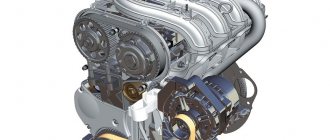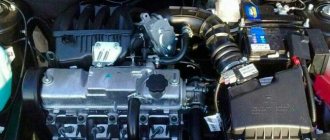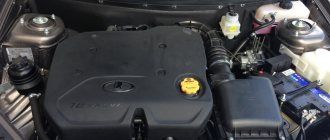The 1.8 engine Lada Vesta SV Cross is the heart of the domestic station wagon, which is one of the most important and significant parts. From this article you will learn absolutely everything about the 16-valve 1.8 Lada Vesta SV Cross engine with index 21179 - its strengths and weaknesses, characteristics, design, etc.
Let's start with a short excursion into history. About 5 years ago, a completely new 16-valve engine with index 21179 appeared on the AvtoVAZ conveyors. Outwardly it was similar to its predecessors, but inside it was very different from them.
Brief content of the entry
Engine problems 1.8 Lada Vesta SV Cross
Knocking of hydraulic compensators Increased oil consumption Broken timing belt Difficult access to some components during repairs
Does the 1.8 Lada Vesta SV Cross engine bend valves when the timing belt breaks?
Yes, the 1.8 Lada Vesta SV Cross engine bends the valve when the timing belt breaks.
What engine does the Lada Vesta 1.8 SV Cross have?
Under the hood of the Lada SV Cross 1.8 there is an engine 21179
Engine 1.8 Lada Vesta resource
The service life of the Lada Vesta 1.8 engine is about 200 thousand km.
Even earlier, in Togliatti there had already been attempts to assemble a 16-valve 1.8, but they were unsuccessful. Although the engine itself was assembled on the basis of the 21124 that was already available at that time, which today is considered one of the most successful VAZ engines. The previous 1.8 received the index 21128. But it never went into production due to an unsuccessful design, increased oil consumption and an extremely short service life. This engine barely reached 100 thousand kilometers and was already in need of major repairs.
The subsidiary produced small-scale Ladas with this engine, but only a few have survived to this day. In particular, 1.8 engines from Super-AUTO were in Lada Priora cars, but this modification never gained popularity, so production was curtailed, postponing 1.8 until better times.
Perspective
It should be noted that the power unit from the Nissan concern is superior to our domestic engines both in many quality and technical characteristics and in terms of efficiency (more reliable, more durable and uses less oil). Surely, not everyone needs exactly record numbers from a car and its engine - most car owners are looking for the most advantageous combination of reliability, practicality and efficiency, and therefore in this case it is worth paying attention to the Lada Vesta with a Nissan engine.
But there is one thing, the installation of the imported H4M engine has been postponed indefinitely, apparently due to the rise in price of the model and, as a consequence, the recoupment of such an upgrade is not profitable.
There is good news, on October 20, 2022, information was received that AvtoVAZ is testing another engine on the Lada Vesta, this is a 1.4-liter gasoline turbo engine from Renault and 150 hp, we’ll find out how this will end a little later.
But in order not to further mislead the public, it is necessary to mention in a few words the combination of these engines with various types of transmissions. So, the 1.8-liter engine is installed on all three types of gearboxes used in Vesta: robotic, mechanical and automatic. A conventional domestic 1.6-liter power unit is combined with a robot and mechanics. The Nissan engine is also installed on all three types of gearboxes. As most car owners understand, a car cannot develop its full engine potential with a robotic gearbox. But the choice of gearbox remains beyond the scope of this article; among the engines, it is worth noting the 1.6-liter Nissan concern due to its higher reliability and efficiency.
Today, dealers offer only 4 versions: - 1.6L 106 hp with a 5MT gearbox and 5ST AMT - 1.8L 122 hp with a 5MT gearbox and 5ST AMT
Video comparison test of 1.6 versus 1.8 engine on Vesta:
AvtoVAZ is developing its 16-valve engines gradually, that is, step by step. When the updated Kalina family appeared in 2013, buyers were perplexed as to why they offered a 106-horsepower engine in manual versions, which differed little in design from the usual Priora engine.
The new engine was equipped with resonant supercharging, and it seemed that its presence would only have disadvantages: reliability was reduced, there was no way to connect the cable drive. But it turned out that the new engine was no worse than its predecessor: the mass air flow sensor often breaks down, and the DBP and DTV sensors almost never. There is no MAF sensor in the design of the 27th engine, which is the secret of increased reliability.
Technical characteristics of the 1.8 Lada Vesta SV Cross engine
In the summary table we have collected the main declared characteristics of the 1.8 Lada Vesta SV Cross engine.
| Index | 21179 |
| engine's type | Petrol |
| Supply system | electronically controlled fuel injection |
| Volume | 1.8 L (1774 cc) |
| Maximum power | 90 kW (122 hp) / (at 5900 rpm) |
| Maximum torque | 170 Nm (at 3700 rpm) |
| Toxicity standard | Euro 5 |
| Recommended fuel | gasoline AI92 or AI95 |
| Average fuel consumption (with manual transmission): | |
| Urban cycle | 10.7 l/100 km |
| Country cycle | 6.4 l/100 km |
| Mixed cycle | 7.9 l/100 km |
| Fuel tank volume | 55 l |
| Maximum speed | 180 km/h |
| Acceleration time 0-100 km/h | 11.2 s |
In general, nothing surprising or outstanding, but at this stage this is all you need to know about the 1.8 Lada Vesta SV Cross engine.
Motor H4M
This is a joint development between Nissan and Renault. Nissan calls the engine HR16DE , and Renault calls it H4M . AvtoVAZ also uses the name from Renault. Main characteristics:
- fuel - gasoline;
- volume – 1.6 liters;
- power – 113 forces;
- torque – 152 Nm.
The gearbox is a Japanese-made JF015E from Jato. Among the features of the motor relative to Russian engines, the following main points can be highlighted:
- timing chain drive;
- aluminum cylinder block;
- solid cast iron sleeves.
With proper maintenance, the engine will last 250 thousand. This engine is quite popular and has mostly positive user ratings. Its main disadvantage is that its maintenance will cost more than engines from VAZ.
Engine design Lada Vesta SV Cross 1.8 21179
Engine 21179 looks like this:
And this is what a real sample looks like:
The main difference between this engine and its predecessors is the presence of a variable valve timing system. In general, this is the first AvtoVAZ engine to be equipped with such a system. But to implement it, a large number of nodes had to be modified.
Let's start with the fact that this motor is controlled by an electronic throttle. Yes, the E-GAZ system is familiar to us from the latest VAZ 2114 and Lada Priora models. But she didn’t bypass Vesta either. And there was no other option - the motor must comply with Euro 5 environmental standards, which means it cannot be done without an electronic throttle.
Next comes a modified intake manifold made of heat-resistant plastic.
To increase the volume of the combustion chamber, the height of the rise and fall of the piston was changed, for which it was necessary to change the crankshaft and connecting rod-piston group. Thanks to all the manipulations, the piston stroke was increased from 75.6 to 84.0 mm. To compensate for friction losses due to the increased piston stroke, the diameters of the crankshaft connecting rod journals were reduced by 4.8 mm (from 47.8 to 43 mm). The crankshaft oil channels have also been changed, and a class mark for the main and connecting rod bearings is now applied to the ends of the CV for more accurate engine assembly.
The connecting rods are made using breaking technology - the lower head of the connecting rod is torn during assembly to more accurately connect the two halves. The connecting rod itself has been reduced in size from 133 to 128 mm, i.e. by 5 mm. AvtoVAZ does not produce connecting rods and piston groups, but purchases them from a third-party company, Federal Mogul. By the way, the pistons are now lightweight and have a graphite coating. The piston rings remain unchanged, except for the oil scraper ring, which is now coated with chrome.
The crankshaft and cylinder block are manufactured at the AvtoVAZ plant in Tolyatti. This is a purely VAZ development.
The most interesting thing, of course, is the timing system. To implement it, it was necessary to completely rework the cylinder head, making additional channels in it for supplying oil to the phase shifter, as well as making a mounting location for the valve and phase sensor. There is a master disk on the intake camshaft, which is used to read the engine speed.
By the way, the camshafts themselves are now hollow inside, which has made them significantly lighter, and they are made by the South Korean company Toyota Tsusho.
To implement this system, it was necessary to install a more efficient Korean GMB oil pump, which produces a capacity of 54–60 liters per minute versus 34–38 liters per minute for the VAZ, as well as modernized main bearings.
The valves are also foreign-made Mahle. They are lightweight to increase inertia and valve opening speed. Corresponding guides, crackers, springs and plates are made for these valves.
The intake camshaft has a phase angle adjustment mechanism. This is a standard design for DSV, but made specifically for the VAZ engine. The supplier is the German company INA, which is widely known in automotive circles and beyond. The timing belt is Continental, with a service life of 180 thousand km. However, I would not trust the manufacturer rather than wait until the end of the resource to replace it. It is better to do routine maintenance earlier than required than to overhaul the engine when it breaks.
What else? We partially mentioned the timing mechanism, but did not mention the rollers and pump. The support and tension rollers are also made by INA.
The tension roller has a new tension mechanism. The pump on this engine is a high-performance one from the Korean company GMB. It is driven by a timing belt.
The fuel rail is also from Continental with high-performance injectors.
Why was the 27th engine replaced with the 29th?
The VAZ-21127 engine was good for everyone, except for one thing - it complied with Euro-4 standards. For Vesta sedans produced since November 2015, this option would not be suitable. It was necessary to solve a difficult problem: to improve the environmental class without increasing the volume and without losing power. And as a result, a new family of 16-valve engines appeared in the VAZ arsenal. We are talking about motors 21129 - they really meet the latest environmental standards.
The first Vesta engine, produced by VAZ
To move to the Euro-5 standard, engine 21127 had to be modified:
- The resonant intake system, as well as the exhaust system, have been completely redesigned;
- The ECU controller (ECM) has received new firmware - even the algorithm that regulates the volume of the resonant chambers has been changed;
- Engines 21127 and 21129 have slightly different compression ratios - 11.0 versus 10.45;
- The engine suspension was also improved: it became possible to mount it on a subframe.
Engine problems 1.8 Lada Vesta SV Cross
The design of the 1.8 Lada Vesta SV Cross engine provides high power, fuel efficiency and a long service life with proper maintenance. However, it was not without problems. The main ones are:
1. Knock of hydraulic compensators . This is not the most serious problem, but it occurs on the 16-valve 1.8 21179. In most cases, the reason for the knocking of hydraulic compensators in the Lada Vesta SV Cross is the incorrectly selected engine oil. It is enough just to change the oil in the engine to a new one, the hydraulic compensators will be pumped and will stop making noise. If this procedure does not help, then more serious repairs will be required - either replacing the hydraulic compensators with new ones (if they are the problem) or checking the oil pressure in the entire system with subsequent repairs.
2. Increased oil consumption. No matter how reliable and simple this engine is, according to AvtoVAZ, it is not spared the problem of oil consumption. Due to the large number of warranty claims from customers, dealers took measurements, sealed the engine, and if oil consumption exceeded the permissible 700 ml, the engine was sent for repair or replaced with a new one.
The engine life is on average 220,000 km, and with proper maintenance it can last 400 thousand. But, if you’re lucky... And the oil-guzzler will bypass it. The reason for the increased oil consumption lies in the piston group, due to which the cylinder walls are broken when the piston is repositioned, which causes engine oil to leak into the combustion chamber and increased oil consumption.
3. Broken timing belt. Although the factory stated that the timing belt runs for all of its 180 thousand km, it is not uncommon for the belt to break long before this mileage. Because of this, the owner ends up with expensive repairs.
4. Difficult access to some components during repairs. Yes, almost all modern cars suffer from this problem and the 1.8 Lada Vesta SV Cross engine is no exception. For example, replacing a timing belt or pump yourself will require the owner to have special tools and a lot of time to get to these parts.
Otherwise, the engine showed itself only on the good side. It is quite “nimble” for its volume, economical, does not cause major problems for the owner, and its maintenance will not put a price on your pocket.
No increase in agility
It’s a paradox, but the rear of the body in the Vesta is better soundproofed than in the Solaris. He has bare metal around the spare tire, and in the VAZ station wagon there are mats glued on here, albeit made of batting, the reserves of which, it seems, have not dried up at the Tolyatti plant since Soviet times. Nevertheless, they exist, and this is reflected: on the move, the Vesta is quieter than the Solaris, although, perhaps, this difference can be attributed to the incredibly noisy tires with low rolling resistance, which the test sedan was shod with .
But it has the advantage of a faster engine. With the same displacement, it produces a dozen more horses, and all of them are easy to climb. And we have Vesta with a new unit - Nissan's, with 113 horsepower, the same one that is familiar to many from the Qashqai, Almera and Juke models. The character of this unit is dual.
On the one hand, in urban conditions, Vesta pleases with its dynamics. In dense traffic on the streets and avenues, it seems quite “alive”, at least not inferior to its numerous competitors. It’s a different matter on the highway - where does the speed go? Actually, nowhere, you just have to “spur” our station wagon and it will respond. That is, at 2000-2500 rpm we just roll, and at 3000 we finally begin to accelerate, but it’s better to reach 4000 rpm, that is, the passport level of maximum torque. It is clear that this takes time, seconds and seconds. 2-3 with Vesta will definitely lose to Solaris in acceleration from 80 to 120 km/h.
I check with a stopwatch: in this range, the VAZ station wagon accelerates in automatic mode in about 10 seconds. Maybe manual gear selection will help the dynamics? Not much. I choose the fourth “stage” - the result is the same, up to tenths of a second. On the third I improve it extremely slightly - by 0.3-04 s. At the same time, by 120 km/h the tachometer needle almost reaches the red rev zone. At the fifth and sixth stages I don’t even check the dynamics, although, judging by the city mode, the fifth “level” of Vesta is more efficient than that of Solaris.
Perhaps the delay is caused by the new transmission? After all, with a Nissan engine we get a Japanese JATCO variator. Alas, buyers of VAZ cars, dissatisfied with the “robot” AMT, did not wait for the automatic machine. Will the CVT please them? After all, a priori there are complaints about him.
Firstly, according to statistics from independent car services, its service life is about 150-170 thousand kilometers. Then, inevitably, serious repairs follow, which can be brought about by a “ragged” rhythm of movement with sharp accelerations and braking. Secondly, for normal service during this period, you should not only not neglect regular maintenance, but also use special oil in the device.
By the way, about the “contents” of the variator. Vesta’s on-board computer does not measure the temperature inside it, but it would be nice to do so. However, the breather, which on the test car was mounted on a flexible hose upward relative to the gearbox housing, protects against its excessive increase. But as it was removed, it was fixed in the holder so weakly that it fell out during movement... The unit is shown in the photo. If the factory workers have not done this, the simplest solution suggests itself: tighten the head of the breather to the holder with a plastic cable tie.
It’s such negligence that spoils the impression of a quite nice and practical car. Moreover, they are raised, as they say, onto a shield and presented as fatal flaws. They blame the Togliatti factory workers, who supposedly inherited the “best traditions” of Soviet assembly, and even the place on which the Volzhsky Automobile Plant was built. In my opinion, there is absolutely nothing criminal in such little things, and my personal impression of the “Vest” with the SW index, on the contrary, consists of positive aspects, for example, the organization of the same trunk. And fixing the breather yourself, in my opinion, is simply interesting. Well, those who wish can complain about a “defect” by contacting the dealership, and they will probably fix it under warranty. My three-year experience of owning an Xray suggests that VAZ is now okay with this.
Does the 1.8 Lada Vesta SV Cross engine bend valves when the timing belt breaks?
Yes, the 1.8 Lada Vesta SV Cross engine bends the valve when the timing belt breaks. This is not a significant disadvantage, since most modern cars are designed in a similar way. It's all about the compression ratio, thanks to which the efficiency of the motor is achieved. If you “unclench” the engine, it will not be as responsive to the gas pedal, and the car will drive much worse.
Therefore, if the timing belt breaks, the water pump or one of the rollers jams, a major repair is guaranteed. But it is not all that bad. It is necessary to change the timing belt and rollers in a timely manner, as well as choose high-quality parts in order to avoid tragic consequences.
Lada Vesta SV engine 1.8 reviews
At the beginning of 2022, I became the owner of a Lada Vesta SV CROSS with a 1.8 liter engine. At the moment, the mileage is 35 thousand km and there are no problems with the engine. It drives decently, stays in line, and doesn't burn oil. In the city this engine is enough. Fuel consumption with my driving style is 10-12 liters in the city and 8-9 on the highway. I think that this is a successful engine from AvtoVAZ. Although, in my case, it’s too early to draw conclusions. If this engine goes up to 100 thousand km without breakdowns, then everything is fine with it!
Dmitriy,
Kazan
This year I bought a used Lada Vesta with a 1.8 liter engine 16 valves 21179. The first thing I encountered was the clatter of hydraulic compensators on a cold car. Especially in winter. For a few seconds after starting, the engine made a loud clicking sound, probably with half of its hydraulics. After 5-10 seconds they gradually subsided. And they didn't cause any more problems. With the onset of heat, the hydraulics began to knock even on a hot engine. The problem was partially solved by switching to Shell Helix HX8 5W40 oil. I'm still watching, but I don't want to do expensive repairs.
Alexei,
Yurga
The worst thing I encountered with this engine was a broken timing belt. Although the mileage is very low for replacement - only 70 thousand km. The plan was to change the belt at 100 thousand, but I didn’t get there. The capital amounted to 50 thousand with spare parts and labor. I can't call this engine reliable, but it drives very well. It starts off great from a traffic light and easily passes all sorts of foreign cars up to two liters. To take it or not to take it - decide for yourself.
Anton,
Perm
Car with internal combustion engine “21129”, test drive on video
Good characteristics, so far I have noted 2 disadvantages for myself: oil consumption of 250 ml per thousand km and recommendations not to fill with 92-grade gasoline (after all, it is more profitable financially, and not all gas stations can find 95-grade in our city).
Vesta 92 is allowed. On the 127 engine the 95th
Well it turns out if 250 ml. for a thousand, then at 12 thousand I have about 1 liter of oil left? Is the oil dipstick lying?
This plant has secured itself. In order to refuse the warranty if something happens. In general, almost 3 liters from replacement to replacement, that’s crazy.
I have 6 pots (3.3 liters), 250 thousand miles, 18 years old car. Oil consumption is about 500 ml per 15 thousand km. From replacement to replacement, there is still some stock left. A 250 ml. per thousand, this is not a minus, this is firewood!
VAZ pleases with his Vesta in everything and even in the choice of engine for the new Vesta! The engine is, of course, powerful and has a lot of power, but if you want to drive fast and so that the car doesn’t suffocate, then you need to pay money for gasoline and oil! Although this engine is more economical than in foreign cars...
))))) more economical. FUNNY, my 1.7 with 130 horses eats about 8 or even less 95 liters in the city, on the highway within 100 km/h it eats 4.5-5.5 liters…. and a maximum of a liter of oil per 10,000, so the mileage on the engine is already more than 260t.km. …..
“Although this engine is more economical than on foreign cars...”
Is it really “powerful”? Is it really “more economical”? I have a 3.3 liter engine, the weight of the car is 1905/2460 kg - it eats 8 liters on the highway. So this engine has been produced since 1991! And there will be fewer valves... And a V-shaped engine... And the car is 18 years old... Do you want a comparison closer to Vesta? I once had a 1.6-liter Opel Cadet (sedan, 1987) - the consumption was 5.6 liters on the highway, although I didn’t drive quietly then.
The characteristics are quite good - I have become closer to my classmates in terms of performance. Although from a tax point of view the previous engine option was preferable.
There's something wrong with the oil. After 8000 km, oil consumption should be
2 liters I drove 8000 km without adding oil. Maybe a mistake, but in fact 250 ml per 10 thousand km?
Thank you for your comment, we will check with the AvtoVAZ representative and we will definitely answer you!
Is the vestemotor really disposable?
Of course it's a mistake! (or the machinations of vasophobes). The first car I had was a Moskvich AZLK 2140; its operating manual indicated oil consumption of 80 g/1000 km, and when this figure increased to 200 g/1000 km, the engine was considered worn out and required major repairs. How can oil consumption be so high on a new modern car? I have only driven 2000 km on my Vesta so far, I constantly monitor the oil, and the level has not dropped either.
What engine does the Lada Vesta 1.8 SV Cross have?
Many people ask this question, but in reality everything is simple. Under the hood of the Lada SV Cross 1.8 there is an engine 21179. This is not a fundamentally new engine, but a modified 1.6 21129. But for the modified version there is a lot of new stuff in it. This is a 16-valve unit with distributed fuel injection, electronic control and a variable valve timing system.
[Episode 42]Largus CROSS with updated engine
View and compare engines
closer: Help in buying a new car: .
The price of the LADA Largus with the new engine remained unchanged: the station wagon costs from 635,400 rubles, the van – from 609,800 rubles, the LADA Largus Cross version – from 689,900 rubles. This is the price of models without various discounts, with which the car will cost significantly less.
As for the features of Largus
with a power unit of 106 hp. (VAZ-21129), then about them is expanded.
The VAZ plant has been producing station wagons and vans of the Largus family since 2011. In 2014, the production of station wagons in the “Cross” body was launched. By that time, AvtoVAZ had localized the assembly of K4M engines, but not K7M, supplied by Renault.
The first of the two engines is equipped with 16 valves, and it became the basis for all trim levels of the crossover station wagon. It is this, and not the 8-valve K7M, although 8-valve internal combustion engines are more suitable for the SUV segment. In fact, the K7M engine is inferior to its 16-valve brother in both power and traction characteristics. And if the Lada Largus Cross engine had been 8-valve, neither the factory nor the buyer would have benefited from this. Let's look at the details.
Engine 1.8 Lada Vesta resource
The service life of the Lada Vesta 1.8 engine is about 200 thousand km. He is very far from becoming a millionaire, and no one makes such engines now because of the economic component.
However, it all depends on many factors, the most important of which is your attitude towards the car and your driving style. If you maintain this engine in a timely manner and use high-quality consumables in the form of oil and filters, and also do not constantly turn up the speed to the red zone, then this engine can cover the entire 400 thousand km.
What is the difference between station wagons and trim levels?
Additional options that only Lada Vesta SW Cross has:
- Original off-road body kit.
- Body color "Mars" (orange, 130).
- Interior color (orange trim).
- Decorative exhaust pipe nozzle.











